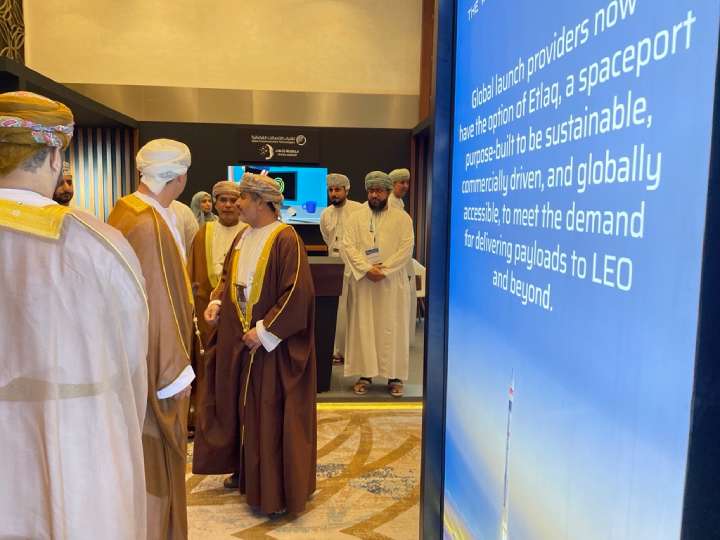
MUSCAT, Oman — Governments remain the largest drivers of growth in the space sector, but there is growing recognition of the importance of diverse funding sources and talent development in sustaining that growth over time.
At the Middle East Space Conference in Oman, hosted by Euroconsult and the Omani Ministry of Transport, Communications and Information Technology (MTCIT), international and regional leaders discussed ways to drive value and long-term growth by investing in a more robust regional startup culture.
Investing in Accelerators and Incubators
One common perception among regional stakeholders is that private money too often funds startups overseas. In a survey of regional stakeholders, Euroconsult found that workforce needs and entrepreneurship were perceived as the two greatest challenges for the Middle East space sector. (A favorable regulatory environment was a close third.)
To address the first two challenges, several countries are funding technology accelerators and incubators to jumpstart high-tech entrepreneurship. Oman’s MTCIT, which houses its nascent Space Program, has been working on capacity-building and workforce development through the establishment of space engineering labs, workshops and also a planned space accelerator.
“We want to gear startups in Oman to look seriously at the space sector opportunities that are here,” said the Undersecretary of the MTCIT, Dr. Ali Al Shidhani, referring to the accelerator program. The demand for space skills is reportedly high in Oman and the supply is mixed between foreign and local resources, he continued. “So, there is room for locals to provide the right supply for demand.”
The Saudi Space Agency (SSA) already launched a program which incubated 50 space companies in the last year. It is also setting up a government-backed venture capital fund and a fund for development and innovation.
Even though most companies incubated in the SSA program were non-Saudi, the benefits are being felt internally, said Mohammed Algassim, the Sector Head of Planning and Development for the Saudi Space Agency. “The idea is: how can we attract those non-Saudis to come to Saudi and establish a base,” he told Constellations. “Last year, we attracted the biggest—from our end—FDI [foreign direct investment] in the space sector with a Hong Kong company that came into Saudi with SAR 1 billion potential FDI. That’s huge for us,” Algassim continued. “One of our plans is attracting foreign talent and attracting foreign companies as well.”
In the UAE, the approach is similarly mixed between incubating local, regional and international startups. During a panel on academic excellence in space, Ali Alshehhi, Director of the National Space Science and Technology Center (NSSTC) in the UAE, discussed ongoing regional collaboration to foster new space enterprises.
“We are not only incubating companies from the UAE but also in the region,” Alshehhi said, citing partnerships with Saudi Arabia, Bahrain and Oman. “We are also discussing the opportunity beyond the GCC,” he continued, pointing to pending work with India and Israel. Based on Alshehhi’s comments, it appears many opportunities are based on a cost-sharing model with partners, which the NSTCC believes will “allow us to really support and incubate the startup ecosystem.”
There is also interest in collaborating with traditional venture capital firms that have proven success connecting startups to capital. For example, Seraphim Capital’s CEO Mark Boggett, speaking with the leader of a national technology investment fund, cited the group’s space technology accelerator, which has an 86% success rate of companies raising capital within 12 months of participating in the program.
Upstream vs. Downstream
The spacefaring nations of the Middle East and North Africa have matured into a $25 billion space market that is on track to comprise some 7.5% of the global space market by the end of the decade, according to Euroconsult. With roughly 90% of the value of the regional space market in downstream services and applications, the countries represented at MESC are taking a varied approach in their mix of upstream and downstream investment.
 Representatives from government agencies addressed space workforce issues and entrepreneurship at the Middle East Space Conference in Muscat, Oman from Jan. 8-10, 2024. (Source: Kratos)
Representatives from government agencies addressed space workforce issues and entrepreneurship at the Middle East Space Conference in Muscat, Oman from Jan. 8-10, 2024. (Source: Kratos)
In keeping with its 2022 national space strategy, Oman has a vision to become “the gateway for space applications.” This emphasis on downstream applications will focus government investment on the use of space data for decision-making on Earth, economic diversification, national security and in-country capacity-building. Part of this effort includes the planned establishment of a network of antennas for ground-as-a-service offerings, the Etlaq spaceport and a new economic zone dedicated to the manufacture and assembly of space tech.
For Saudi Arabia, the government is more focused on directing investment toward upstream infrastructure, space exploration and funding new space activities that have yet to prove market viability, such as debris mitigation and commercial space stations. As Algassim explained, “Downstream is a focus for us but it’s not a government focus. …It needs to be led by the private sector.”
To that effect, 70% of Saudi Arabia’s space budget is geared toward noncommercial activities, including establishing infrastructure for sector enablement. It is also using resources to attract foreign direct investment and encourage companies to set up shop in the Kingdom.
Bahrain, which is also working to advance its digital economy, is addressing the seven pillars of its space strategy, which includes an emphasis on building national capacity through regional and commercial cooperation and fostering a regulatory environment to support the expansion of the national space sector.
Building an Ecosystem from Existing Infrastructure
While the development of sovereign space capabilities remains a critical capability, investors noted that it is not the be-all-end-all for a robust national space economy. Overall capacity within the global space sector is growing, with estimates that GEO capacity could triple and LEO capacity could exceed 180 Tbps in less than five years. There is also promising growth in the number of launch providers, spacecraft manufacturers and other upstream capabilities.
In a panel on space investment in the Middle East, Ulrich Hermann, Managing General Partner of Einstein Industries Ventures, cited the model of low-cost launch infrastructure, pioneered by SpaceX, as an example of capacity in need of use. “If you see the infrastructure now, … they need business.” Hermann went on to compare the untapped space infrastructure to the internet before the advent of platforms like Amazon, Google and the proliferation of software applications. “All this is missing,” he continued. “But it’s coming. Why is it coming? Because the industry demands it.”
It’s unclear who will meet that demand. However, with the ongoing investment in the next generation of entrepreneurs, emerging space nations are positioned to not only leverage global advances but contribute significantly to the increasing value of the space ecosystem.
Explore More:
Podcast: The Opportunities, Challenges and Future of the Middle East Space Sector
Flurry of Partnerships Signal Arrival of Middle East as a Major Space Player
Industry Report Highlights: What Happens When You Triple On-Orbit Capacity?
AI in Space: From Protecting Satellites to Building New Business Models
